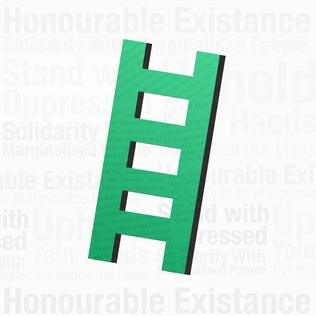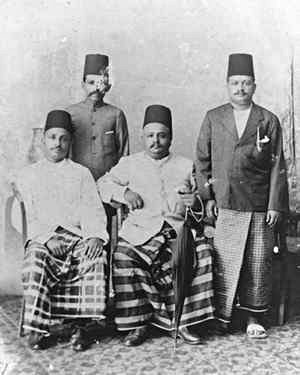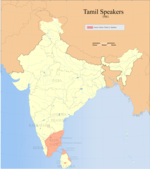
The Dravida Munnetra Kazhagam is an Indian political party based in the state of Tamil Nadu, where it is currently the ruling party, and the union territory of Puducherry, where it is currently the main opposition.

Indian Union Muslim League is a political party primarily based in Kerala. It is recognised as a State Party in Kerala by the Election Commission of India.

Ilaiyangudi is a town in Sivaganga district, Tamil Nadu state, India. It is the center of government for the surrounding tehsils. The town has a predominant Tamil Rowthers population. The Tamil Muslim community was traditionally engaged in Business. Bazaar(Kadai Theru) is the central business district.
The Marakkars are a South Asian Muslim community found in parts of the Indian states of Kerala, Tamil Nadu, and Sri Lanka. The Marakkars speak Malayalam in Kerala and Tamil in Tamil Nadu and both Tamil and Sinhala in Sri Lanka.

Sri Lankan Moors are an ethnic minority group in Sri Lanka, comprising 9.3% of the country's total population. Most of them are native speakers of the Tamil language. The majority of Moors who are not native to the North and East also speak Sinhalese as a second language. They are predominantly followers of Islam. The Sri Lankan Muslim community is mostly divided between Sri Lankan Moors, Indian Moors, Sri Lankan Malays and Sri Lankan Bohras. These groups are differentiated by lineage, language, history, culture and traditions.

Islam arrived in Kerala, the Malayalam-speaking region in the south-western tip of India, through Middle Eastern merchants. The Indian coast has an ancient relation with West Asia and the Middle East, even during the pre-Islamic period.
Dravida Nadu is the name of a proposed sovereign state demanded by the Justice Party led by the founder of the self-respect movement, E.V. Ramasamy Periyar, and the Dravida Munnetra Kazhagam (DMK) led by C. N. Annadurai for the speakers of the Dravidian languages in South India.

The Vanniyar, also spelled Vanniya, formerly known as the Palli, are a Dravidian community or jāti found in the northern part of the Indian state of Tamil Nadu.
Labbay, are a Tamil Muslim trading community in southern India found throughout the southern Indian states of Tamil Nadu, Karnataka, Kerala and Andhra Pradesh. The Labbay are a subgroup within the Tamil Muslim community.
Podakkudi is a village in Thiruvarur district in the South Indian state of Tamil Nadu. The town is located at a distance of 20 km (12 mi) from the district headquarters Thiruvarur and 272 km (169 mi) from the state capital Chennai. Podakkudi is known for the Big Pallivasal, a prominent Islamic shrine. Nearby town is Koothanallur and the nearby villages are Atthikadai and Budamangalam.
Politics of Tamil Nadu is the politics related to the Indian state of Tamil Nadu.

The Rowther are originally a Tamil community from the Indian state of Tamil Nadu and Kerala. they were converted to Islam by the preacher Nathar Shah. Even after conversion they retained their caste name. they were elite cavalrymen of the Chola and Pandya kingdoms. They were traditionally a martial clan like the Maravars, and constitute large part of the multi-ethnic Tamil Muslim community. Rowthers have also been found as Tamil polygars, zamindars and chieftains from the 16th to 18th centuries. The traditional homelands of the Rowthers were in the interior of Southern Tamilakam.
Dravidian parties include an array of regional political parties in the state of Tamil Nadu, India, which trace their origins and ideologies either directly or indirectly to the Justice Party and the Dravidian movement of C. Natesanar and Periyar E. V. Ramasamy. The Dravidian movement was based on the linguistic divide in India, where most of the Northern Indian, Eastern Indian and Western Indian languages are classified as Indo-Aryan, whereas the South Indian languages are classified as Dravidian. Dravidian politics has developed by associating itself to the Dravidian community. The original goal of Dravidian politics was to achieve social equality, but it later championed the cause of ending the domination of North India over the politics and economy of the South Indian province known as Madras Presidency.

Erode Venkatappa Ramasamy, revered by his followers as Periyar or Thanthai Periyar, was an Indian social activist and politician who started the Self-Respect Movement and Dravidar Kazhagam. He is known as the 'Father of the Dravidian movement'. He rebelled against Brahmin dominance and gender and caste inequality in Tamil Nadu. Since 2021, the Indian state of Tamil Nadu celebrates his birth anniversary as 'Social Justice Day'.
Umaru Pulavar was a Tamil Muslim poet from Tamil Nadu, India. Umaru Pulavar was born in 1642 in the town of Ettayapuram in Thoothukudi district. He is celebrated as one of the greatest Islamic poets of India.

M. Muhammad Ismail was an Indian politician and social worker from southern Indian state Tamil Nadu. he was a founder of the Indian Union Muslim League party after the partition of British India. He was popularly known in Tamil Nadu and Kerala as the "Quaid-e-Millat" .. Ismail was a member of Madras Legislative Assembly and Leader of the Opposition (1946—52). He was also a member (1948—50) of the Constituent Assembly, the drafting body of the constitution of India. He was also a member of Rajya Sabha (1952—58) and Lok Sabha.
Kulasekharapatnam is a town in the Thoothukudi district of Tamil Nadu, India.
Religion in Tamil Nadu consists of various religions practiced by the populace of the state. Hinduism is the predominant religion in the state with significant Christian and Muslim minorities. As a home to a multitude of religions, the Tamil culture reflects the influence of the same. Various places of worship are spread across the state.
K. S. G. Haja Shareef was an Indian industrialist and politician from Tamil Nadu. Shareef served in the Madras Legislative Assembly and its successor body, the Tamil Nadu Legislative Assembly, from 1957 to 1967 and from 1980 to 1984. A member of the Indian National Congress, Shareef was the Leader of the Opposition in the Tamil Nadu Legislative Assembly from 1983 until 1984.
















